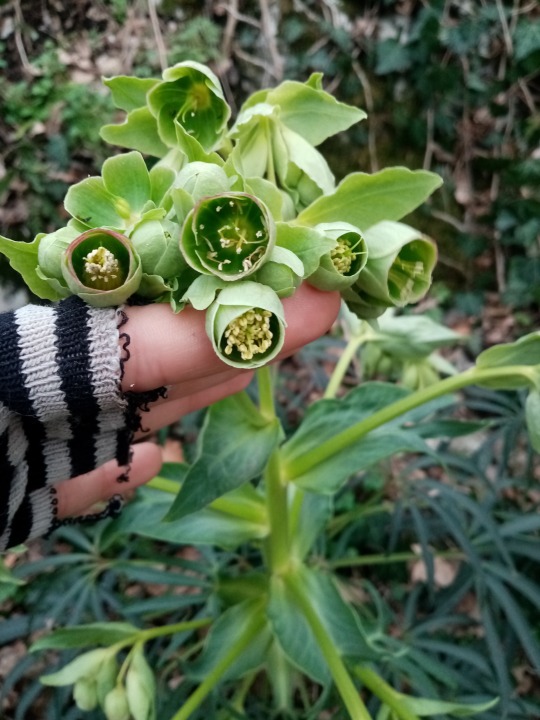#Elleborus Foetidus
Explore tagged Tumblr posts
Text
After a very interesting discussion with @mercuryo-cronyco <3, I learn that in Switzerland the plant is also named Pestwurz, probably an Nth confusion with another species, but nevertheless Pestwurz means "pestilence plant", which would be appropriate ; and in the use that one made of it (violent purgative used in the case of poisoning and black humors among other things) ; and in the image that folklore still has of it, in my region (French Alps) its name is still "Wolf-Killer".
I also found (looking for information on another plant) this :
To the hellebore has been attributed since Antiquity the virtue of curing madness : the name of this plant would come from the Semitic helibar (or helebar, or hellebar), which means "remedy against madness".
Two other etymologies are also proposed for hellebore :
- one, rather improbable : hellos, young deer, and bora, food, pasture
- the other, generally accepted, helein, "to kill" and bora, food, that is to say "the food that kills", in reference to the extreme toxicity of the plant, which has been source of serious accidents
-
But the plant is not that toxic if we compare for example with Veratrum Album. Ellebore was a very common name for a lot of strong purgative plants since Antiquity it seems.
------------------------------------------------------------------------------
NOW, a bit of pure herbalism because I'm not sure it's all clear and defined so far:
Purgative : It was a matter of cleansing "vicious" humors, of restoring the body to its purity.
There were of course several kinds of purgatives as well as different forces.
Cathartic (considered the least violent) / Emetic (considered the worst, i.e a vomiting) / Diuretic (i.e Aperitif> basically means a "digestive", so it's a matter of preparing the body to have a good digestion) / Sodoriferous (to sweat)
The Ellebore-> and all the plants related to it were, according to all the research I did, a plant reputed to be a DRASTIC purgative (so reputed to be the most violent for the body; and when the Ancients say "violent", it means that in their various attempts to purge the bodies, a large number ended in the death of the said body.)
Hellebore ‘fetid’.
[Extract from the Dictionary of Medicinal and Poisonous Plants by P.V Fournier.]

- Popular names : Griffin’s foot, lion’s foot, bear’s paw, snake rose, horse-bites, snake bread, …
- Habitat and flowering :
Flowering usually occurs after 4 to 9 years, usually the plant dies after its second flowering. It is umbelliferous, even in the heart of winter. Plant very common in France in calcareous soils, not or hardly ever found in clay soils.
- History :
In antiquity the hellebore played a big role in the treatment of mental and nervous disorders, madness, epilepsy, various paralysis, etc. Dioscorides speaks of its purgative properties (in fact, properties that the wine of vines bordering many feet of Hellebore, received.)
- Poisoning :
helleboreine is a digitalis-type heart poison (…)
Poisoning is manifested by irritation of the mouth and throat, a flow of saliva, heaviness of the head, dizziness, ringing in the ears dilation of the pupils, slowing of the pulse, a feeling of malaise, sometimes fits and convulsions, nausea / stomach pain / diarrhea, difficult breathing, then colds and death from cardiac arrest.
It should be noted that, just as with digitalis, the effects of the toxic principles of Hellebore accumulate, so continued low doses can become fatal.

- Medicinal uses :
1 / It has long been used as a cardiac tonic by decoction of the plant at 1%, but this is no longer used because of its difficult resistance to elimination.
2 / It was used before for melancholy, hypochondria, hysteria, rheumatic crises, intermittent fevers, sores, eschares, etc.
3 / It can be very useful as a purgative and dewormer when it is handled with care. Following the example of the ancients, its leaves can be macerated moderately in vinegar, or simply moisten them with liquor, then extract the juice and mix it with syrup or honey. Thus prepared, it does not cause nausea or vomiting.
4 / In homeopathy, the tincture taken from the dry root, a yellow liquid with a virulent smell and a burning flavor, is indicated in the following cases: psychosis, cerebral congestion, collapse, dropsy, renal congestion, weakness of the heart, etc.
5 / External use is dangerous: applied for a few moments to a bleeding wound, the root immediately causes vomiting.
However, an ointment, composed of 4 to 8g of root for 30g of lard removes the scabs. (which do not leave by other means.)
#Ellebore#Elleborus Foetidus#Poison#Great Old Lady of the Mountains#my dear dear Old Lady of The Mountains <3#Fournier
51 notes
·
View notes